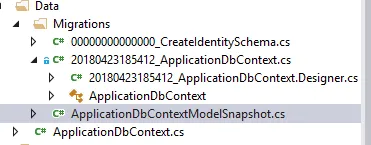我正在尝试向我的ApplicationUser类添加属性,但在添加属性后更新数据库时遇到了问题。我做错了什么?我只是想在用户对象中存储声明的结果,以便更轻松地访问它。
我正在尝试使用以下命令来更新数据库:
每次运行命令时,我都在NuGet包管理器中运行它。我还尝试通过命令提示符在项目文件夹中运行命令(但没有成功,并出现了类似的错误输出)。
版本信息:
- Entity Framework Core和Entity Framework 6都已安装。 Entity Framework Core工具正在运行。我在我的命令前加了
错误:
'GenericArguments[0], 'MyWebsite1.Data.Migrations.ApplicationDbContext', on 'Microsoft.EntityFrameworkCore.Design.IDesignTimeDbContextFactory`1[TContext]' violates the constraint of type 'TContext'.'
我的ApplicationUser类:
这是位于ApplicationDbContext : Migration中的
当我按照这里的步骤进行操作时,运行了
我的迁移记录如下图所示:
我正在尝试使用以下命令来更新数据库:
EntityFrameworkCore\Add-Migration -Name ApplicationDbContext。每次运行命令时,我都在NuGet包管理器中运行它。我还尝试通过命令提示符在项目文件夹中运行命令(但没有成功,并出现了类似的错误输出)。
版本信息:
- Entity Framework Core和Entity Framework 6都已安装。 Entity Framework Core工具正在运行。我在我的命令前加了
EntityFrameworkCore\
- dotnet --version 2.1.101错误:
'GenericArguments[0], 'MyWebsite1.Data.Migrations.ApplicationDbContext', on 'Microsoft.EntityFrameworkCore.Design.IDesignTimeDbContextFactory`1[TContext]' violates the constraint of type 'TContext'.'
我的ApplicationUser类:
public class ApplicationUser : IdentityUser
{
public string LGID { get; } = "";
public string CoIDs { get; } = "";
public string LGIDSuperUserName { get; set; } = "unknown"; //recently added
public bool IsSuperUser { get; set; } = false; //recently added
public ApplicationUser() { }
public ApplicationUser(ClaimsIdentity identity)
{
IEnumerable<Claim> claims = identity.Claims;
foreach (Claim c in claims)
{
if (c.Type == "LGID")
LGID = c.Value;
if (c.Type == "CoIDs")
CoIDs = c.Value;
if (c.Type == "LGIDSuperUser")
LGIDSuperUserName = c.Value;
if (c.Type == "IsSuperUser")
IsSuperUser = c.Value.ToLower()=="yes";
}
}
}
这是位于ApplicationDbContext : Migration中的
Up方法: protected override void Up(MigrationBuilder migrationBuilder)
{
migrationBuilder.DropIndex(
name: "UserNameIndex",
table: "AspNetUsers");
migrationBuilder.DropIndex(
name: "IX_AspNetUserRoles_UserId",
table: "AspNetUserRoles");
migrationBuilder.DropIndex(
name: "RoleNameIndex",
table: "AspNetRoles");
migrationBuilder.AddColumn<bool>(
name: "IsSuperUser",
table: "AspNetUsers",
nullable: false,
defaultValue: false);
migrationBuilder.AddColumn<string>(
name: "LGIDSuperUserName",
table: "AspNetUsers",
nullable: true);
migrationBuilder.CreateIndex(
name: "UserNameIndex",
table: "AspNetUsers",
column: "NormalizedUserName",
unique: true,
filter: "[NormalizedUserName] IS NOT NULL");
migrationBuilder.CreateIndex(
name: "RoleNameIndex",
table: "AspNetRoles",
column: "NormalizedName",
unique: true,
filter: "[NormalizedName] IS NOT NULL");
migrationBuilder.AddForeignKey(
name: "FK_AspNetUserTokens_AspNetUsers_UserId",
table: "AspNetUserTokens",
column: "UserId",
principalTable: "AspNetUsers",
principalColumn: "Id",
onDelete: ReferentialAction.Cascade);
}
ApplicationDbContext
public class ApplicationDbContext : IdentityDbContext<ApplicationUser>
{
public ApplicationDbContext(DbContextOptions<ApplicationDbContext> options)
: base(options)
{
}
protected override void OnModelCreating(ModelBuilder builder)
{
base.OnModelCreating(builder);
// Customize the ASP.NET Identity model and override the defaults if needed.
// For example, you can rename the ASP.NET Identity table names and more.
// Add your customizations after calling base.OnModelCreating(builder);
}
}
我的.csproj文件:
<?xml version="1.0" encoding="utf-8"?>
<Project ToolsVersion="15.0" xmlns="http://schemas.microsoft.com/developer/msbuild/2003">
<PropertyGroup>
<_SelectedScaffolderID>MvcControllerWithContextScaffolder</_SelectedScaffolderID>
<_SelectedScaffolderCategoryPath>root/Common</_SelectedScaffolderCategoryPath>
<WebStackScaffolding_ControllerDialogWidth>600</WebStackScaffolding_ControllerDialogWidth>
<WebStackScaffolding_DbContextDialogWidth>600</WebStackScaffolding_DbContextDialogWidth>
<WebStackScaffolding_ViewDialogWidth>600</WebStackScaffolding_ViewDialogWidth>
<WebStackScaffolding_IsLayoutPageSelected>False</WebStackScaffolding_IsLayoutPageSelected>
<WebStackScaffolding_IsPartialViewSelected>False</WebStackScaffolding_IsPartialViewSelected>
<WebStackScaffolding_IsReferencingScriptLibrariesSelected>False</WebStackScaffolding_IsReferencingScriptLibrariesSelected>
<ActiveDebugProfile>IIS Express</ActiveDebugProfile>
<NameOfLastUsedPublishProfile>FolderProfile</NameOfLastUsedPublishProfile>
<Controller_SelectedScaffolderID>MvcControllerEmptyScaffolder</Controller_SelectedScaffolderID>
<Controller_SelectedScaffolderCategoryPath>root/Controller</Controller_SelectedScaffolderCategoryPath>
<WebStackScaffolding_IsAsyncSelected>False</WebStackScaffolding_IsAsyncSelected>
</PropertyGroup>
<PropertyGroup Condition="'$(Configuration)|$(Platform)'=='Debug|AnyCPU'">
<DebuggerFlavor>ProjectDebugger</DebuggerFlavor>
</PropertyGroup>
<DotNetCliToolReference
Include="Microsoft.EntityFrameworkCore.Tools.DotNet"
Version=”1.0.0” />
</Project>
当我按照这里的步骤进行操作时,运行了
dotnet ef migrations add superuser_test命令后,我得到了错误提示:dotnet : No executable found matching command "dotnet-ef"。尽管我的.csproj中包含了DotNetCliToolReference并已运行dotnet restore。我的迁移记录如下图所示:
